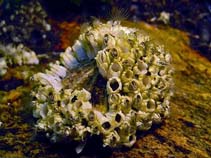Balanus crenatus Bruguière, 1789
Crenate barnacle| Native range | All suitable habitat | Point map | Year 2050 |

|
| This map was computer-generated and has not yet been reviewed. |
| Balanus crenatus AquaMaps Data sources: GBIF OBIS |
Classification / Names Common names | Synonyms | CoL | ITIS | WoRMS
| Balanomorpha | Balanidae
Environment: milieu / climate zone / depth range / distribution range يسانش موب
; روش بل; قمع تارييغت 1 - 182 m (Ref. 126559). Temperate
شنكارپ اهروشك | )OAF( يناهج راب و راوخ نامزاس قطانم | Ecosystems | روهظ | يفرعم
Arctic, Eastern Pacific, Northern Atlantic and the Mediterranean: Canadian Arctic Archipelago and British Isles.
Length at first maturity / Size / Weight / نس
Maturity: Lm ? range ? - ? cm Max length : 2.0 cm WD يسنج صاوخ نودب / رن سنج; (Ref. 3719)
Most commonly found in the subtidal zone, on the underside of smooth rocks, but very infrequently on highly brackish water. Individuals occur as fouling organisms on ship bottoms and docks, inside crab carapace, mussle shells, and plate limpets, also in bottles, wood, and kelp (Ref. 126559). Naupliar stage larvae are found in the water column and are flushed back into the sea with the fresh water outflow. Larvae migrate into estuaries at a later stage where they settle (Ref. 126559). Found in muddy substrates associated with organic pollutants (Ref. 96352) and on mixed sediments with gravel, pebbles and sand (Ref. 118257). This is an attached (Ref. 3123), epibenthic species (Ref. 95730). Suspension feeder (Ref. 118257). A microvore that feeds on organic detritus (Ref. 96352).
Life cycle and mating behavior غولب | لثم دیلوت | یزیر مخت | اه مخت | Fecundity | )ورال ( دازوت
Members of the superorder Thoracica are mostly hermaphroditic. Broadcast spawners, fertilization occurs in the mantle cavity. Life cycle: Eggs hatch into planktonic nauplii and leave the mantle cavity. Afterwards, they undergo six naupliar instars succeded by nonfeeding cypris larva (settling stage) which later metamorphose into adults.
یلصا ذخآم
عجارم | هدننك گنهامه | ناراكمه
Organisation for Economic Co-operation and Development. 1963. (Ref. 3719)
NCUI زمرق تسرهف رد تيعضو (Ref. 130435)
ستياس رظن زا تيعضو (Ref. 108899)
Not Evaluated
CMS (Ref. 116361)
Not Evaluated
اه ناسنا یارب رطخ
یناسنا هدافتسا
| FishSource |
اهرازبا
رتشيب تاعالطا
Age/Size
دشر
نزو - لوط
لوط - لوط
يسانش تخير
)ورال ( دازوت
يناوارف
دشر
نزو - لوط
لوط - لوط
يسانش تخير
)ورال ( دازوت
يناوارف
يتنرتنيا عبانم
BHL | BOLD Systems | CISTI | DiscoverLife | FAO(Publication : search) | Fishipedia | GenBank (مونژ, ديتوئلکون) | GloBI | Gomexsi | Google Books | Google Scholar | Google | PubMed | Tree of Life | Wikipedia (ورب, وجتسج) | Zoological Record
Estimates based on models
Preferred temperature
(Ref. 115969): 4 - 12.8, mean 9.1 (based on 674 cells).
تميق هقبط
(Ref. 80766):
Unknown.



